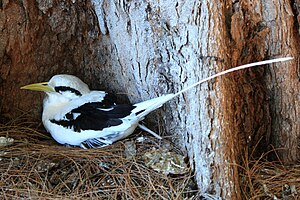White-tailed tropical bird
| White-tailed tropical bird | ||||||||||
|---|---|---|---|---|---|---|---|---|---|---|

White-tailed tropical bird ( Phaethon lepturus ) |
||||||||||
| Systematics | ||||||||||
|
||||||||||
| Scientific name | ||||||||||
| Phaethon lepturus | ||||||||||
| Daudin , 1802 |
The white-tailed tropical bird ( Phaethon lepturus ) is the smallest of the three tropical bird species. He spends most of his time in the open seas of the tropical oceans.
The IUCN classifies the white-tailed tropical bird as not endangered ( least concern ).
features
Half of the 70 to 90 centimeters body length of the white-tailed tropical bird is accounted for by the tail. Equally noticeable are its long wings with black tips and black stripes on the upper wings and its streamlined body, which give it a graceful appearance. Further features are a black eye stripe and a yellow beak. The wingspan is 90 to 95 centimeters. The beak is pointed. It is usually yellow, but there are also individuals with orange, reddish, or gray beaks. The iris is dark brown. The legs are greenish white. There is no noticeable sexual dimorphism . Fledglings do not yet have extended tail feathers. The call is a high "kee-kee-krrrt-krrt-krrt".
On the high seas, tropical white-tailed birds can usually only be observed individually. They fly very high and have powerful flapping of their wings. Often they follow ships and boats, often they stay in the air while shaking before they settle on walls or ropes. Outside of the breeding season, they are almost never seen over land, they rest floating on the surface of the water, with their tails sticking out of the water. On land they are very clumsy, as the legs, which are placed far back and the feet, which are small in relation to their height, cannot support the body weight. They crawl across the ground on their chests and push themselves forward with their wings. Above the sea they are not very happy to shout, on the other hand numerous noises can be heard in the breeding colonies.
There is a possibility of confusion with terns , among other things , but these have a different build and flight pattern. They also have a forked tail. The pure white fairy tern is significantly smaller than the white-tailed tropical bird. There are similarities to the other tropical birds. The respective distribution area of the red-tailed tropical bird and the white-tailed tropical bird overlaps; the red-tailed tropical bird is larger and more powerfully built. The elongated red tail feathers characteristic of the red-tailed tropical bird cannot always be clearly identified when observing the field. However, this species has a bright red beak that is more noticeable.
distribution
The tropical white-tailed bird is a pantropical species of bird found in the Pacific, southern tropical Indian and Atlantic Oceans, and the Caribbean Sea. Stray visitors also reach the south of Africa, the west coast of North America and New Zealand. The species prefers bodies of water whose surface temperature does not exceed 22 ° C. Off the Christmas Island , the white-tailed tropical bird prefers to be in the coastal waters, which have a low salinity .
White-tailed tropical birds breed on tropical islands and atolls.
Food and subsistence
The white-tailed tropical bird feeds on fish and cephalopods. The proportion varies depending on the distribution. He is a shock diver who dives into the water for hunting from heights of up to 20 meters. Occasionally he also catches flying fish during their flight phase. They forage for food only during the day, usually foraging alone or in pairs. In the vicinity of foraging white-tailed tropical birds, however, red-footed boobies , fairy terns, black-winged storm grebes , noddis and slender-billed noddis are also common . Especially during the nestling period, it looks for food in waters closer to the coast than the red-tailed tropical bird.
Reproduction
When the bird was four years old, it first came to breed on tropical island coasts. Mating, which can take place all year round, is initiated with synchronized courtship flights. A single egg is laid on the bare ground or in a recess between tree roots or rocks. Both parent animals incubate the egg for about 40 days.

There are 5 subspecies
- P. l. lepturus - Indian Ocean
- P. l. fulvus - Christmas Island
- P. l. dorotheae - tropical pacific
- P. l. catesbyi - Bermuda and the Caribbean
- P. l. ascensionis - Ascension
supporting documents
literature
- PJ Higgins (Ed.): Handbook of Australian, New Zealand & Antarctic Birds. Volume 1: Ratites to Ducks. Oxford University Press, Oxford 1990, ISBN 0-19-553068-3 .
Web links
- Phaethon lepturus in the endangered Red List species the IUCN 2008. Posted by: BirdLife International, 2004. Retrieved on January 6 of 2009.
- Videos, photos and sound recordings for Phaethon lepturus in the Internet Bird Collection
Single receipts
- ↑ a b c Higgins, p. 945.
- ^ Higgins, p. 946.
- ↑ Nigel Redman, Terry Stevenson, John Fanshawe: Birds of the Horn of Africa: Ethiopia, Eritrea, Djibouti, Somalia, and Socotra - Revised and Expanded Edition . Princeton University Press , 2016, ISBN 978-0-691-17289-7 , pp. 42 (English, full text in the Google book search).

